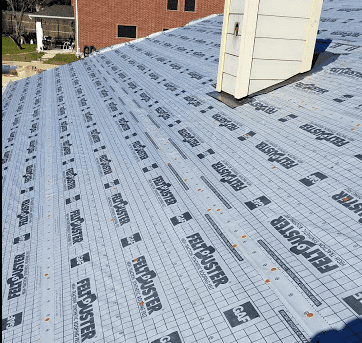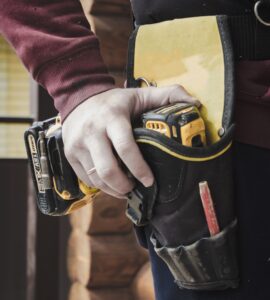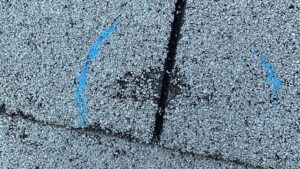When it comes time to replace your roof, it will be replaced with more than simply new shingles. Many other components come together to form a safe, weather-proof covering for your property. The underlayment is one component of this. Though it doesn’t get the attention it deserves, it’s an important part of keeping your home safe and dry.
What Is Underlayment?
Your roof’s structural component, known as the roof deck, is protected by a layer of underlayment. In order to protect the wood beneath it, it stands on top of the building. Roof decks composed of OSB, plywood, or step sheathing are common. Rafters and trusses secure the roof deck to the house.
This construction has an underlayment on top of it. You need it as a layer of defense.

Why Is Underlayment So Important to Your Roof?
There’s no doubt that a new roof deck will be robust, dry, and protective of the house. ” However, if the deck components are exposed, water can still enter the house. In addition to protecting the roof deck and trusses from water damage, underlayment also helps keep your family safe from the elements.
Roof underlayment has other advantages, such as:
A high-wind storm or damage from an object striking the surface can cause shingles to fall off of your roof.
During the installation procedure, it acts as a weather shield for the roof. As a result, it acts as a barrier between the roof deck and the shingles.
As a result, you’ll see less damage to your roof’s deck from things like ice dams and other winter-related problems.
Almost everywhere, an underlayment is required by local building rules, not merely because of the benefits it provides. Underlayment is usually required by the majority of shingle makers as well.
Types of Underlayment Available
Roofing underlayment can be chosen from a variety of options depending on the property’s circumstances, price, and other objectives. When hiring a roofer for a new roof, inquire about the sort of underlayment and why it is being utilized.
Here are some of the most popular varieties of underlayment and why they’re utilized.
Asphalt-saturated Felt
Underlayment made of asphalt-saturated felt has been around for a long time. Older roofs that haven’t been updated in a while are likely to have this problem. Felt paper and tar paper are other names for this product. It can be made from cellulose, bitumen, polyester, and asphalt, as well as other components. This is a multipurpose tool that is simple to use and has a high level of dependability.
Rubberized Asphalt
The most expensive roofing underlayment is rubberized asphalt. Because it contains more rubber polymers and asphalt, the price is higher. However, the most important feature is that the roof is completely watertight. For long-term usage, it is one of the best solutions for protecting against water.
Synthetic Underlayment
One of the most often utilized items today is synthetic underlayment. It can withstand a lot of rain and snow without any problems. Since the basemat is asphalt-soaked, it’s reinforced with fiberglass mixes to make it more durable. The underlayment’s exceptional water resistance is a result of this special blend of materials. As a result, it is less prone to tearing or deterioration in storms or other challenging conditions. Comparatively, the cost of this product falls somewhat in the middle of the pack.
There are a variety of criteria that go into the selection of an underlayment, and your roofer will take all of these into account when making this decision. Manufacturers may recommend a certain type of roofing underlayment in various cases. Some of the time, it’s a matter of where the house is located.
Different Underlayment for Different Climates
In addition to the weather conditions where you reside, you can choose an underlayment that best suits your needs. Moisture and damage prevention is the primary objective of all underlayments. Various environments may be better suited to different people.
Traditional Asphalt Underlayment: Typically, this is not used in damp locations due to the lack of weather-proofing. The temperature can also lead to asphalt cracking because it becomes stiffer when it’s colder. This can cause the underlayment to break down before it’s ready to do so.
Synthetic Underlayment: In places where snow and freezing conditions are widespread, this sort of underlayment is a superior option. As a result, it can flex and move with the ice rather than snap at low temperatures since it does not become brittle
Ice and Water Shielding: Look for a synthetic underlayment with ice and water protection to improve flexibility and durability while also improving adhesion to the roof deck, especially in harsh conditions.
Peel and Stick Underlayment: Peel and stick underlayment is a popular choice for certain homeowners. Although it is more expensive, it tends to provide the maximum amount of moisture protection that might cause damage to the roof or the development of mold. The strong adhesion of this product makes it a popular choice in environments where extreme weather conditions abound.
Consult with your roofing contractor to identify the best underlayment for your house’s roofing needs and requirements. However, keep in mind that a higher-quality underlayment will help protect your house, so it’s worth it to spend a little more money up front.
Always Work with the Best
If it’s time to replace your roof, hire a company that’s dedicated to meeting your needs. Midwest Roof and Solar has been trusted in the Minneapolis area for over 20 years for superior workmanship and affordable roofing solutions. Contact us today for an estimate.





